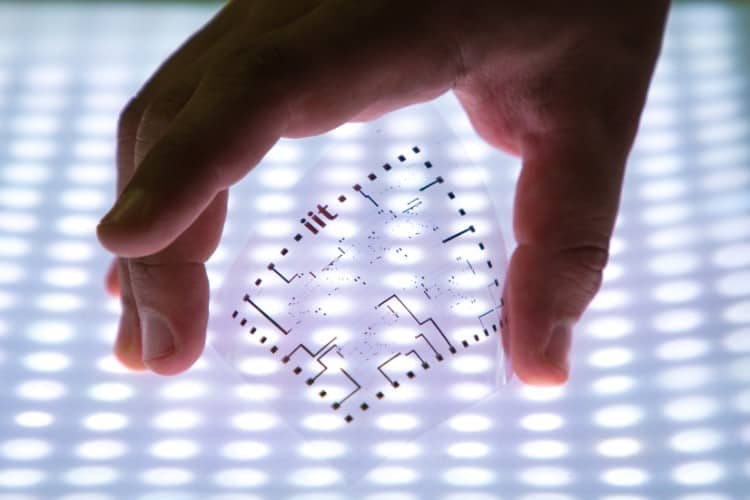
A Beginner’s Guide to Flexible Electronics
November 19, 2019 - Emily Newton
Revolutionized is reader-supported. When you buy through links on our site, we may earn an affiliate commision. Learn more here.
From GPS systems to using smartphones and home computers to file our taxes and search for jobs, each of us is already inundated with transistors, circuit boards and processors. So where do flexible electronics fit into this landscape?
The future of computing is mobile, after all. Our digital lives are sequestered inside operating systems designed for on-the-go use. This has given rise to an explosion in new form factors and product designs — including wearables for our wrists, eyes and ears, folding screens, “digital paper” and now multi-screen devices.
We need lightweight, portable and rugged computers because we take them everywhere. If glass-clad smartphones are the present, then flexible and even foldable phones and other electronics are the future.
But what are flexible electronics? How do they work, and why are they the future of digital devices?
How Do Flexible Electronics Work?
Traditional electronics use inflexible substrates in the construction of their circuit boards. These are typically made from fiberglass (epoxy resin reinforced with glass fibers) or from resin and paper. Both types incorporate copper foil for antistatic and anti-electromagnetic properties.
The trouble with these substrates is that they cannot bend. When bent, ordinary circuit boards will either break outright or delaminate. When delamination occurs, the various layers of the circuit board separate, causing immediate or intermittent operational failure. To prevent this and give the finished product a higher degree of durability, circuit boards are becoming more flexible.
Flexible electronics, or “flex circuits,” instead of fiberglass substrates, use much more pliable materials such as flexible plastics, polyester conductive film or polyimide (a strong, heat-resistant synthetic polymer). Circuits in smart credit cards may also use stretchable silicon.
As for conductors, most flexible circuit designs use liquid metals combined with stretchable polymers to provide both conductivity and flexibility. Iridium and gallium replace more familiar and brittle conductors like silver, gold or copper.
Multiple Roads to Flexible Electronics
There is also the problem of processors themselves. Some researchers propose using a single-crystal organic transistor, patterned over a large operational area, in place of individually manufactured traditional transistors. Printing these transistors onto flexible plastics yields circuits that can be bent repeatedly and still function.
Other researchers are going a different route.
Processors are typically “etched” into silicon wafers that are not at all conducive to bending or folding. Recent research has yielded an exciting, although primitive, microprocessor design based on “2D semiconductors.”The microprocessor in question contains 115 transistors (hence “primitive”) placed on transition-metal dichalcogenide (TMD). Unlike a silicon wafer, 2D materials like TMD are just molecules thick, giving them unprecedented flexibility. The researchers claim their design has implications for sensors, batteries and, of course, computer chips.
In addition to TMD, there are several other materials under consideration that may play a future role in flexible electronics. These include:
- Graphene
- Carbon nanotubes
- Boron nitride (BN)
The concept of flexible electronics isn’t new, but interest in the idea has perhaps never been more widespread or intense. Satellites have used thin solar cells made from crystalline silicon since the 1960s to survive the rigors of outer space.
By 2008, various combinations of these materials were producing electronics that could stretch by up to 70% of their original size without losing conductivity. These days, some flexible electronics can stretch by a mind-blowing 1,000%.
The consumer technology sector will continue to reap the benefits. Today, according to findings by Grand View Research, the flexible electronics industry is worth billions. By 2024, it could reach $87.21 billion in total value.
What Does the Future Hold?
Flexible electronics present implications for the future of consumer lifestyles as well as several industries. These include:
- Thinner and lighter electronics: Flexible substrates can be much thinner than traditional ones. This cuts down on weight in portable electronics as well as larger electronic devices, like digital signs or automobile guidance systems.
- More durable, longer-lasting devices: For all their remarkable capabilities, most modern electronics are extremely fragile unless built to specific rugged military specifications. Flexible conductors, elastic processors and stretchable circuit boards will help electronics last longer and survive previously fatal drops and collisions.
- Less manufacturing waste: The cost to manufacture flexible electronics will vary by device. In pursuit of cost savings, some manufacturers are targeting roll-to-roll manufacturing — similar to the way newspapers are made from huge rolls of paper — as a way to cut costs and reduce wasted materials.
Perhaps the most exciting implication at the consumer level is the sheer amount of raw innovation that flexible electronics will unlock. Besides allowing us to design digital devices in a dizzying array of new shapes and sizes, flexible electronics will help innovators place computing power in brand-new places.
Innovations
- Folding displays for mobile electronics
- “Electronic paper” we can crumple or fold to pocket-size
- Digital banners and signage that behaves like fabric
- Cheaper and more robust sensors for shipping cartons, mobile electronics and field use
- More cost-effective and longer-lasting solar cells
- Flexible and highly biocompatible medical devices and implants
Samsung treated the world to a real-world beta test of flexible consumer electronics with the Galaxy Fold.
The device is far enough ahead of its time that it provides a roadmap for improvements yet to come. Importantly, flexible circuit boards and displays need a housing that’s equally robust and flexible.
We’ve been hearing about e-paper newspapers for years. We’re still not there, but we’re getting closer. The future will give us exciting breakthroughs in flexible batteries and electronics. They’ll bend and stretch to suit any environment or the contours of the human body.
Until then, it’s going to be enjoyable watching the required technology and material science come of age.
Revolutionized is reader-supported. When you buy through links on our site, we may earn an affiliate commision. Learn more here.
Author
Emily Newton
Emily Newton is a technology and industrial journalist and the Editor in Chief of Revolutionized. She manages the sites publishing schedule, SEO optimization and content strategy. Emily enjoys writing and researching articles about how technology is changing every industry. When she isn't working, Emily enjoys playing video games or curling up with a good book.




